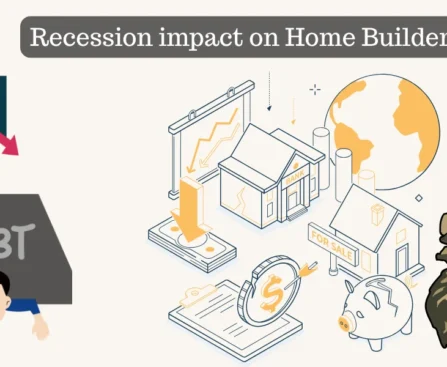Builders and Developers: Reduced Demand: During a recession, demand for new construction projects, whether residential or commercial, typically decreases. Homebuyers may delay purchases, and businesses may postpone expansion plans, leading to a slowdown in construction activity. Financial Challenges: Builders and developers may face financial challenges as projects become financially unviable or face delays. Difficulty securing funding for ongoing or new projects may arise. Distressed Inventory: Economic downturns can result in distressed properties, including unsold homes or commercial spaces. Builders and developers may need to reduce prices to sell distressed properties, leading to reduced profit margins. Project Delays: Financing difficulties, reduced demand, and uncertainty can lead to project delays. Project delays can increase construction costs and impact the ability to meet deadlines. Reassessment of Plans: Builders and developers may need to reassess their development plans. There may be a shift toward more affordable or lower-risk projects during a recession. Bankers and Lenders: Risk Management: Banks and lenders may become more cautious during a recession, leading to stricter lending criteria and reduced risk tolerance. Securing financing may become more challenging for borrowers. Increased Loan Defaults: Economic hardship can lead to an increase in loan defaults and non-performing loans. Banks may need to allocate more resources to managing distressed assets. Lower Profit Margins: Reduced lending opportunities and increased risk can impact the profitability of banks and financial institutions. Larger reserves for loan losses may need to be set aside. Impact on Real Estate Loans: Banks heavily involved in real estate lending may see the value of their loan portfolios affected by declining property values and increased default rates. Regulatory Changes: Governments and regulators may introduce measures to stabilize the financial sector during a recession. Regulatory changes can affect how banks and lenders operate and manage real estate loans. It’s crucial to note that the impact of a recession on these stakeholders can vary based on the severity of the economic downturn, government policies, and specific circumstances. Effective risk management, financial resilience, and adaptability are essential for navigating economic challenges and making informed decisions about projects and lending practices during a recession.
Introduction Bioconcrete is a revolutionary and sustainable construction material designed to address common issues associated with traditional concrete, such as cracks, corrosion, and the need for frequent maintenance. It introduces a remarkable self-healing mechanism that enhances the durability and lifespan of concrete structures. Components of Bioconcrete 1. Bacteria Specifically selected and engineered bacteria, typically of the genus Bacillus or Sporosarcina, are embedded in the concrete mix. These bacteria are chosen for their ability to thrive in the alkaline environment of concrete. 2. Nutrients Calcium lactate or another suitable nutrient source is added to the concrete mix. This nutrient source serves as food for the embedded bacteria. Self-Healing Process 1. Activation When the concrete experiences cracking due to factors like shrinkage, physical stress, or environmental exposure, water can infiltrate the cracks. This moisture triggers the activation of the embedded bacteria. 2. Biomineralization Once activated, the bacteria start consuming the nutrient source and metabolize it to produce calcite (calcium carbonate). Calcite is a naturally occurring mineral that can seal and fill the cracks in the concrete. 3. Healing As the bacteria-produced calcite accumulates within the cracks, it effectively “heals” the damaged area, restoring the structural integrity of the concrete. Advantages of Bioconcrete Durability: The self-healing properties increase the material’s lifespan, reducing the need for frequent repairs or replacements. Sustainability: By decreasing the frequency of repair and replacement, bioconcrete reduces the environmental impact associated with maintenance and construction. Cost-Efficiency: While bioconcrete may be more expensive initially, the long-term savings in maintenance costs can outweigh the initial investment. Safety: Bioconcrete is safe to use in construction, and the bacteria used in its composition do not pose health risks. Ongoing Research and Future Potential Bioconcrete is an emerging technology, and research is ongoing to improve its efficiency, cost-effectiveness, and applicability in various construction scenarios. While it may not completely eliminate the need for traditional repair methods, it has the potential to significantly enhance the durability and sustainability of concrete structures.
Renovating Your Home: 10 Inspiring Ideas One popular home renovation idea is to open up the living space. This can be achieved by removing walls or creating open-concept floor plans. By doing so, you can create a more spacious and inviting environment for entertaining guests and spending time with family. Another popular option is to update the kitchen. The kitchen is often considered the heart of the home, and a kitchen remodeling project can greatly increase the value and functionality of your space. Consider installing new cabinets, countertops, and appliances to give your kitchen a fresh and modern look. If you have limited space, consider adding storage solutions to maximize your available space. Built-in shelving, under-the-stair storage, and closet organizers can help you make the most of every inch of your home. Upgrading the bathroom is also a popular home renovation idea. Consider replacing outdated fixtures, installing a new vanity, or adding a walk-in shower to create a more luxurious and spa-like atmosphere. Energy efficiency is another important factor to consider when planning your home renovation. Upgrading windows, insulation, and appliances can not only help you reduce your energy bills but also make your home more environmentally friendly. When considering home renovation ideas, it’s important to choose projects that align with your budget, personal preferences, and long-term goals for your space. By carefully planning and selecting the right renovations, you can transform your home into a more functional, stylish, and valuable space. To kickstart your creativity, we’ve compiled a list of 10 inspiring home renovation ideas that might just spark your next project. 1. Open Concept Living One of the most sought-after trends in home design is open-concept living. Knocking down walls to create a seamless flow between your kitchen, dining area, and living room can make your home feel more spacious and welcoming. Check out stunning before-and-after photos of successful open concept renovations for ideas. 2. Kitchen Makeover The heart of the home, your kitchen, deserves special attention. A kitchen renovation can completely transform your space. Explore popular design trends such as kitchen islands, stylish backsplashes, and state-of-the-art smart appliances. The possibilities are endless! 3. Bathroom Bliss A well-designed bathroom can be a sanctuary in your home. Consider features like walk-in showers, freestanding tubs, and elegant dual sinks to create a spa-like atmosphere. Beautifully designed bathrooms are sure to inspire your renovation project. 4. Cozy Outdoor Retreat Don’t forget about your outdoor spaces! Renovating your backyard can provide a wonderful retreat for relaxation and entertainment. Explore ideas like building a deck, patio, or even an outdoor kitchen for enjoyable outdoor living. 5. Sustainable Upgrades Thinking green? Sustainable renovations not only benefit the environment but also save you money in the long run. Discover options like energy-efficient windows, solar panels, and eco-friendly building materials. Dive into success stories of homeowners who reduced their environmental footprint. 6. Vintage Revival If you have a historic home, consider a vintage revival. Restore and preserve the charm of your vintage property while incorporating modern amenities. The result? A harmonious blend of old-world charm and contemporary comfort. 7. Smart Home Innovations Bring your home into the 21st century with smart home innovations. Explore the possibilities of automation, advanced security systems, and voice-controlled devices. Witness how technology can elevate your renovation project. 8. Basement Transformation Basements often hide untapped potential. Transform your basement into a functional living space. Ideas like a home theater, gym, or guest suite can turn this often-underutilized area into a valuable part of your home. 9. Creative Storage Solutions Effective storage is the cornerstone of an organized home. Discover creative storage solutions for small spaces, such as built-in shelving and hidden storage compartments. Let these ideas help you declutter and organize your living spaces. 10. Exterior Facelift First impressions matter, so don’t neglect your home’s exterior. Enhance your curb appeal with landscaping, new siding, or a front door upgrade. Witness the incredible transformations that boosted property values. Conclusion Embarking on a home renovation project is an opportunity to bring your vision to life and create a space that truly reflects your lifestyle. These 10 inspiring home renovation ideas should help you kickstart your creativity and guide you in the right direction. Remember, the key to a successful renovation is careful planning and attention to detail. So, go ahead, dream big, and turn your home into the space you’ve always envisioned.
Thumb Rule for Concrete Mix In civil engineering and construction, a common thumb rule for concrete mixes is the 1:2:3 ratio. This ratio represents the proportion of ingredients in the mix, where 1 part is cement, 2 parts are fine aggregates (such as sand), and 3 parts are coarse aggregates (such as crushed stone or gravel). The specific ratios may vary based on the required strength and characteristics of the concrete being produced. Thumb Rule for Concrete Work When working with concrete, a practical thumb rule is to follow recommended mix ratios and proportions. This ensures the desired strength and durability of the concrete. Thumb rules can include guidelines for cement quantity, aggregate proportions, and water-cement ratios based on the type of construction project. Cement Required In Brickwork The amount of cement required in brickwork can vary based on factors such as brick size, mortar thickness, and construction specifications. A common approach is to use a mix with the appropriate cement-to-sand ratio to achieve the desired strength for the brick masonry. Important Thumb Rule For Plastering Plastering requires a different set of thumb rules, including the mix ratio of plastering materials, curing practices, and surface preparation. Adhering to these thumb rules ensures a smooth and durable plaster finish on walls and surfaces. Bulk Density of Cement The bulk density of cement is an important parameter in concrete mix design. It refers to the mass of cement per unit volume. Understanding and controlling the bulk density is crucial for achieving the desired properties of concrete. Types of Concrete Concrete comes in various types, each designed for specific applications. Common types include ready-mix concrete, precast concrete, high-strength concrete, and self-compacting concrete. The choice depends on project requirements and construction needs. Setting Time of Cement The setting time of cement refers to the time it takes for the cement to harden and gain strength. Factors such as cement type, temperature, and water-cement ratio influence the setting time. Understanding setting times is crucial for proper construction scheduling. the main The “1:2:3 thumb rule” in concrete refers to a simplified ratio used for mixing concrete ingredients. It is a quick and straightforward guideline for estimating the proportions of key components in a concrete mix. The numbers 1, 2, and 3 represent the following: 1 part Cement: This part represents the volume or weight of cement in the mix. It is the binding agent that provides strength and durability to the concrete. 2 parts Fine Aggregates (such as Sand): This part represents the volume or weight of fine aggregates. Fine aggregates contribute to the workability and cohesiveness of the concrete mix. 3 parts Coarse Aggregates (such as Crushed Stone or Gravel): This part represents the volume or weight of coarse aggregates. Coarse aggregates provide strength to the concrete and contribute to its structural integrity.
Interesting Dir Br MediaFire Direct Link .com A2Place.com NC Directory Kengairu Link Directory Simple Directory Ocsum Directory Thales Directory Indian Construction Industry – Construction Directory Sites Directory



